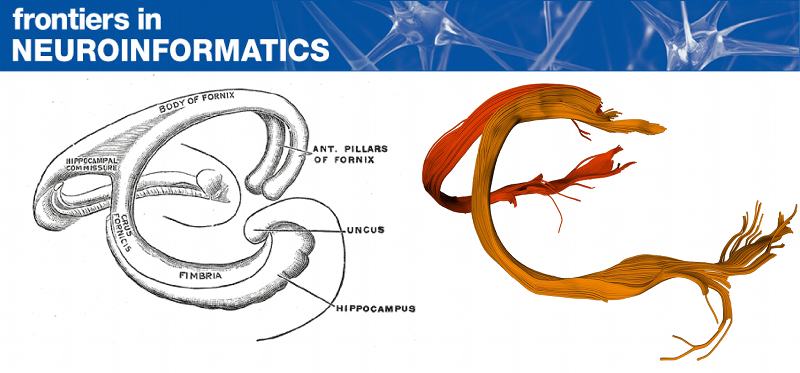Older Highlights#
DIPY 1.10.0 is now available. New features include:
NF: Patch2Self3 - Large improvements of self-supervised denoising method added.
NF: Fiber density and spread from ODF using Bingham distributions method added.
NF: Iteratively reweighted least squares for robust fitting of diffusion models added.
NF: NDC - Neighboring DWI Correlation quality metric added.
NF: DAM - DWI-based tissue classification method added.
NF: New Parallel Backends (Ray, joblib, Dask) for fitting reconstruction methods added.
RF: Deprecation of Tensorflow support. PyTorch support is now the default.
Transition to Keyword-only arguments (PEP 3102).
Zero-warnings policy (CIs, Compilation, doc generation) adopted.
Adoption of ruff for automatic style enforcement.
Transition to using f-strings.
Citation system updated. It is more uniform and robust.
Multiple Workflows updated.
Multiple DIPY Horizon features updated.
Large documentation update.
Closed 250 issues and merged 185 pull requests.
DIPY 1.9.0 is now available. New features include:
Numpy 2.0.0 support.
DeepN4 novel DL-based N4 Bias Correction method added.
Multiple Workflows added.
Large update of DIPY Horizon features.
Pytest for Cython files (
*.pyx) added.Large documentation update.
Support of Python 3.8 removed.
Closed 142 issues and merged 60 pull requests.
DIPY 1.8.0 is now available. New features include:
Python 3.12.0 support.
Cython 3.0.0 compatibility.
Migrated to Meson build system. Setuptools is no more.
EVAC+ novel DL-based brain extraction method added.
Parallel Transport Tractography (PTT) 10X faster.
Many Horizon updates. Fast overlays of many images.
New Correlation Tensor Imaging (CTI) method added.
Improved warnings for optional dependencies.
Large documentation update. New theme/design integration.
Closed 197 issues and merged 130 pull requests.
DIPY 1.7.0 is now available. New features include:
NF: BundleWarp - Streamline-based nonlinear registration method for bundles added.
NF: DKI+ - Diffusion Kurtosis modeling with advanced constraints added.
NF: Synb0 - Synthetic b0 creation added using deep learning added.
NF: New Parallel Transport Tractography (PTT) added.
NF: Fast Streamline Search algorithm added.
NF: New denoising methods based on 1D CNN added.
Handle Asymmetric Spherical Functions.
Large update of DIPY Horizon features.
Multiple Workflows updated
Large codebase cleaning.
Large documentation update. Integration of Sphinx-Gallery.
Closed 53 issues and merged 34 pull requests.
DIPY 1.6.0 is now available. New features include:
NF: Unbiased groupwise linear bundle registration added.
NF: MAP+ constraints added.
Generalized PCA to less than 3 spatial dims.
Add positivity constraints to QTI.
Ability to apply Symmetric Diffeomorphic Registration to points/streamlines.
New Human Connectome Project (HCP) data fetcher added.
New Healthy Brain Network (HBN) data fetcher added.
Multiple Workflows updated (DTIFlow, LPCAFlow, MPPCA) and added (RUMBAFlow).
Ability to handle VTP files.
Large codebase cleaning.
Large documentation update.
Closed 75 issues and merged 41 pull requests.
DIPY 1.5.0 is now available. New features include:
New reconstruction model added: Q-space Trajectory Imaging (QTI).
New reconstruction model added: Robust and Unbiased Model-BAsed Spherical Deconvolution (RUMBA-SD).
New reconstruction model added: Residual block Deep Neural Network (ResDNN).
Masking management in Affine Registration added.
Multiple Workflows updated (DTIFlow, DKIFlow, ImageRegistrationFlow) and added (MotionCorrectionFlow).
Compatibility with Python 3.10 added.
Migrations from Azure Pipeline to Github Actions.
Large codebase cleaning.
New parallelisation module added.
dipy.io.bvectxtmodule deprecated.New DIPY Horizon features (ROI Visualizer, random colors flag).
Large documentation update.
Closed 129 issues and merged 72 pull requests.
DIPY 1.4.1 is now available. New features include:
Patch2Self and its documentation updated.
BUAN and Recobundles documentation updated.
Standardization and improvement of the multiprocessing / multithreading rules.
Community and governance information added.
New surface seeding module for tractography named mesh.
Large update of Cython code in respect of the last standard.
Large documentation update.
Closed 61 issues and merged 28 pull requests.
DIPY 1.4.0 is now available. New features include:
New self-supervised denoising algorithm Patch2Self added.
BUAN and RecoBundles documentation updated.
Response function refactored and clarified.
B-tensor allowed with response functions.
Large Command Line Interface (CLI) documentation updated.
Public API for Registration added.
Large documentation update.
Closed 47 issues and merged 19 pull requests.
DIPY 1.3.0 is now available. New features include:
Gibbs Ringing correction 10X faster.
Spherical harmonics basis definitions updated.
Added SMT2 metrics from mean signal diffusion kurtosis.
New interface functions added to the registration module.
New linear transform added to the registration module.
New tutorials for DIPY command line interfaces.
Fixed compatibility issues with different dependencies.
Tqdm (multiplatform progress bar for data downloading) dependency added.
Large documentation update.
Bundle section highlight from BUAN added in Horizon.
Closed 134 issues and merged 49 pull requests.
DIPY 1.2.0 is now available. New features include:
New command line interfaces for group analysis: BUAN.
Added b-tensor encoding for gradient table.
Better support for single shell or multi-shell response functions.
Stats module refactored.
Numpy minimum version is 1.2.0.
Fixed compatibilities with FURY 0.6+, VTK9+, CVXPY 1.1+.
Added multiple tutorials for DIPY command line interfaces.
Updated SH basis convention.
Improved performance of tissue classification.
Fixed a memory overlap bug (multi_median).
Large documentation update (typography / references).
Closed 256 issues and merged 94 pull requests.
DIPY 1.1.1 is now available. New features include:
New module for deep learning
dipy.nn(uses TensorFlow 2.0).Improved DKI performance and increased utilities.
Non-linear and RESTORE fits from DTI compatible now with DKI.
Numerical solutions for estimating axial, radial and mean kurtosis.
Added Kurtosis Fractional Anisotropy by Glenn et al. 2015.
Added Mean Kurtosis Tensor by Hansen et al. 2013.
Nibabel minimum version is 3.0.0.
Azure CI added and Appveyor CI removed.
New command line interfaces for LPCA, MPPCA and Gibbs unringing.
New MSMT CSD tutorial added.
Horizon refactored and updated to support StatefulTractograms.
Speeded up all cython modules by using a smarter configuration setting.
All tutorials updated to API changes and 2 new tutorials added.
Large documentation update.
Closed 126 issues and merged 50 pull requests.
DIPY 1.0.0 is now available. New features include:
Critical API changes
Large refactoring of tracking API.
New denoising algorithm: MP-PCA.
New Gibbs ringing removal.
New interpolation module:
dipy.core.interpolation.New reconstruction models: MTMS-CSD, Mean Signal DKI.
Increased coordinate systems consistency.
New object to manage safely tractography data: StatefulTractogram
New command line interface for downloading datasets: FetchFlow
Horizon updated, medical visualization interface powered by QuickBundlesX.
Removed all deprecated functions and parameters.
Removed compatibility with Python 2.7.
Updated minimum dependencies version (Numpy, Scipy).
All tutorials updated to API changes and 3 new added.
Large documentation update.
Closed 289 issues and merged 98 pull requests.
DIPY 0.16.0 is now available. New features include:
Horizon, medical visualization interface powered by QuickBundlesX.
New Tractometry tools: Bundle Analysis / Bundle Profiles.
New reconstruction model: IVIM MIX (Variable Projection).
New command line interface: Affine and Diffeomorphic Registration.
New command line interface: Probabilistic, Deterministic and PFT Tracking.
Integration of Cython Guidelines for developers.
Replacement of Nose by Pytest.
Documentation update.
Closed 103 issues and merged 41 pull requests.
DIPY 0.15.0 is now available. New features include:
Updated RecoBundles for automatic anatomical bundle segmentation.
New Reconstruction Model: qtau-dMRI.
New command line interfaces (e.g. dipy_slr).
New continuous integration with AppVeyor CI.
Nibabel Streamlines API now used almost everywhere for better memory management.
Compatibility with Python 3.7.
Many tutorials added or updated (5 New).
Large documentation update.
Moved visualization module to a new library: FURY.
Closed 287 issues and merged 93 pull requests.
DIPY 0.14 is now available. New features include:
RecoBundles: anatomically relevant segmentation of bundles
New super fast clustering algorithm: QuickBundlesX
New tracking algorithm: Particle Filtering Tracking.
New tracking algorithm: Probabilistic Residual Bootstrap Tracking.
Integration of the Streamlines API for reading, saving and processing tractograms.
Fiber ORientation Estimated using Continuous Axially Symmetric Tensors (Forecast).
New command line interfaces.
Deprecated fvtk (old visualization framework).
A range of new visualization improvements.
Large documentation update.
DIPY 0.13.0 is now available. New features include:
Faster local PCA implementation.
Fixed different issues with OpenMP and Windows / macOS.
Replacement of cvxopt by cvxpy.
Replacement of Pytables by h5py.
Updated API to support latest numpy version (1.14).
New user interfaces for visualization.
Large documentation update.
DIPY 0.12.0 is now available. New features include:
IVIM Simultaneous modeling of perfusion and diffusion.
MAPL, tissue microstructure estimation using Laplacian-regularized MAP-MRI.
DKI-based microstructural modelling.
Free water diffusion tensor imaging.
Denoising using Local PCA.
Streamline-based registration (SLR).
Fiber to bundle coherence (FBC) measures.
Bayesian MRF-based tissue classification.
New API for integrated user interfaces.
New hdf5 file (.pam5) for saving reconstruction results.
Interactive slicing of images, ODFs and peaks.
Updated API to support latest numpy versions.
New system for automatically generating command line interfaces.
Faster computation of cross correlation for image registration.
DIPY 0.11.0 is now available. New features include:
New framework for contextual enhancement of ODFs.
Compatibility with numpy (1.11).
Compatibility with VTK 7.0 which supports Python 3.x.
Faster PIESNO for noise estimation.
Reorient gradient directions according to motion correction parameters.
Supporting Python 3.3+ but not 3.2.
Reduced memory usage in DTI.
DSI now can use datasets with multiple b0s.
Fixed different issues with Windows 64bit and Python 3.5.
DIPY 0.10.1 is now available. New features in this release include:
Compatibility with new versions of scipy (0.16) and numpy (1.10).
New cleaner visualization API, including compatibility with VTK 6, and functions to create your own interactive visualizations.
Diffusion Kurtosis Imaging (DKI): Google Summer of Code work by Rafael Henriques.
Mean Apparent Propagator (MAP) MRI for tissue microstructure estimation.
Anisotropic Power Maps from spherical harmonic coefficients.
A new framework for affine registration of images.
DIPY was an official exhibitor for OHBM 2015.
DIPY 0.9.2 is now available for download. Here is a summary of the new features.
Anatomically Constrained Tissue Classifiers for Tracking
Massive speedup of Constrained Spherical Deconvolution (CSD)
Recursive calibration of response function for CSD
New experimental framework for clustering
Improvements and 10X speedup for Quickbundles
Improvements in Linear Fascicle Evaluation (LiFE)
New implementation of Geodesic Anisotropy
New efficient transformation functions for registration
Sparse Fascicle Model supports acquisitions with multiple b-values
DIPY 0.8.0 is now available for download. The new release contains state-of-the-art algorithms for diffusion MRI registration, reconstruction, denoising, statistical evaluation, fiber tracking and validation of tracking.
For more information about DIPY, read the DIPY paper in Frontiers in Neuroinformatics.
So, how similar are your bundles to the real anatomy? Learn how to optimize your analysis as we did to create the fornix of the figure above, by reading the tutorials in our gallery.
In DIPY we care about methods which can solve complex problems efficiently and robustly. QuickBundles is one of the many state-of-the-art algorithms found in DIPY. It can be used to simplify large datasets of streamlines. See our gallery of examples and try QuickBundles with your data. Here is a video of QuickBundles applied on a simple dataset.

